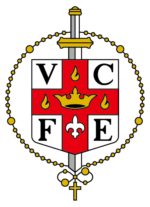In addition to the vows of chastity, poverty and obedience, the religious of the Institute of the Incarnate Word make a fourth vow, of consecration in filial slavery of love to the Blessed Virgin Mary, so as to better serve Our Lord Jesus Christ (IVE Constitutions #82). One of the means to effectively live out this Marian aspect of our charism is to honor Our Blessed Mother in the Shrines where she has chosen to particularly manifest her presence and maternal care.
Towards this end, some members of House of Formation, made a pilgrimage to the Shrine of Our Lady of Antipolo, in the province Rizal. This Shrine, which is also the Cathedral Church of the Diocese of Antipolo, houses of one of the most celebrated and revered images of Our Lady in the Philippine Islands.
Our Lady of Antipolo has had a colorful past, filled with much adventure, from the moment this image was brought to the Philippines from Mexico by Governor General Juan de Niño Tavora in 1626 until it’s permanent enshrinement in the current location.
Also called Our Lady of Peace and Good Voyage, this title originated from one of the most fascinating aspects of an already storied history. In the 250 years of the Galleon Trade, from 1563 to 1815, the vessels making the voyage across the Pacific suffered much at the hands of pirates and the treacherous weather. The passage, from Acapulco in Mexico to Manila was so unpredictable that the Philippine economy began to suffer from the many vessels lost at sea.
To mitigate against this threat, the image of Our Lady was proclaimed as Patron of the Galleons and accompanied the galleons in making the Pacific Crossing, and always successfully returning, each time, adding to her renown.
If you pay close attention to the image of Our Lady, you can see that the figure, carved of Mexican hardwood, is scarred with gash marks on her face and neck. These were from the Chinese Uprising against the Spanish in 1639, when, in response to exorbitant taxes, they attacked and set fire to the Jesuit Church where the sculpture was housed and attempted even to burn the statue itself. When it failed to catch fire, in what is accounted as one of the miracles of Our Lady of Antipolo, the rioters slashed at the bust with machetes in an effort to decapitate it.
Our pilgrims knelt in prayer before the High Altar of the packed Church where Our Lady of Antipolo is enthroned, having been canonically crowned by the Most Reverend Michael J. Doherty, the Archbishop of Manila on the 26th of November 1926 at Luneta before a crowd of over a hundred thousand. Our Act of Thanksgiving for the opportunity to make this pilgrimage to her shrine concluded with the singing of the Salve Regina.
The tale of how the image came to be in this particular location is miraculous. From Intramuros, after the uprising, this statue of Our Lady was brought to the Church of Santa Cruz, then under the care of the Jesuits. The image was said to disappear from the altar of the Church on at least two occasions and each time was recovered from the branches of the tipulo tree. The Jesuits then had a Church built on the site and the tree itself was cut down and fashioned into a pedestal for the image, now called ang tipulo, the Virgin of Antipolo.
Here, the specialty delicacies are the local version of rice cakes or suman and also cashew nuts, or kasoy, and we managed to sample this treat from one of the vendors peddling outside the Cathedral.
In the vicinity of the Shrine of Our Lady of Antipolo is also a famous waterfall, Hinulugang Taktak and we detoured to this scenic locale to enjoy a brief respite amidst the beauty of the natural surroundings.
Our last stop on this brief pilgrimage was to the old Church of St. Jerome, located at the foot of the picturesque descent. This Church, with its ornate bell tower and stone façade, houses a relic of its patron and is an active parish Church.
Taking advantage of the Adoration Chapel at the Church, we made an Act of Thanksgiving to Our Lord Jesus Christ for the many graces which we have received during this pilgrimage to the Shrine of His Blessed Mother and we commended our safe return to the Seminary and the remainder of our journey through the tempests and gales of this Valley of Tears towards our Heavenly Home in the maternal hands of Our Lady of Peace and Good Voyage.

Leave A Comment